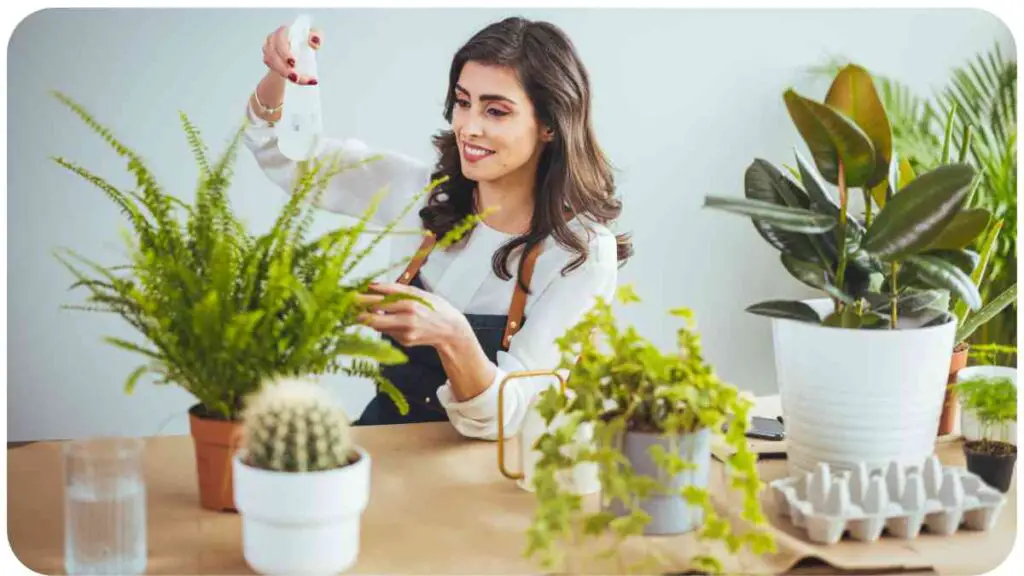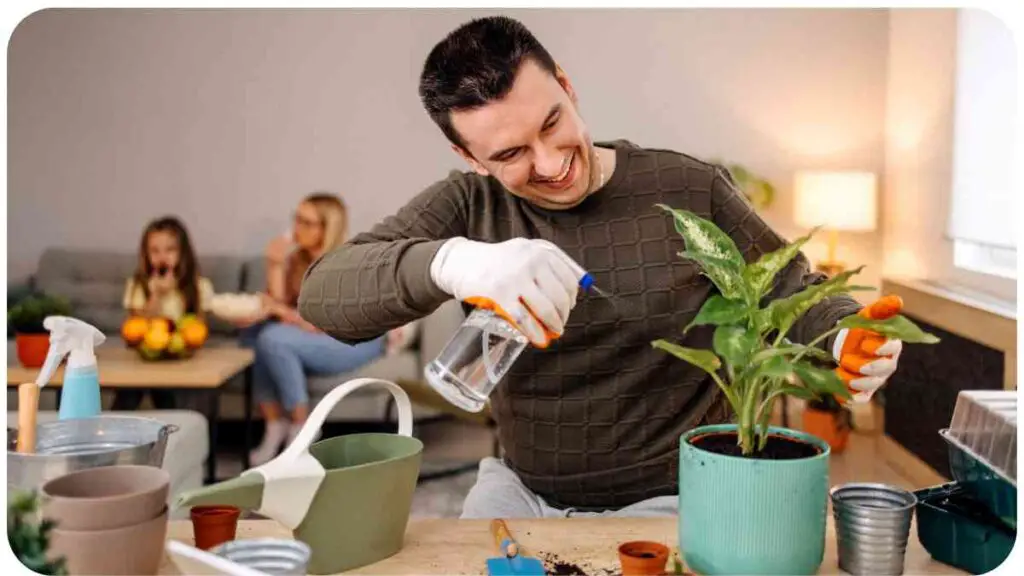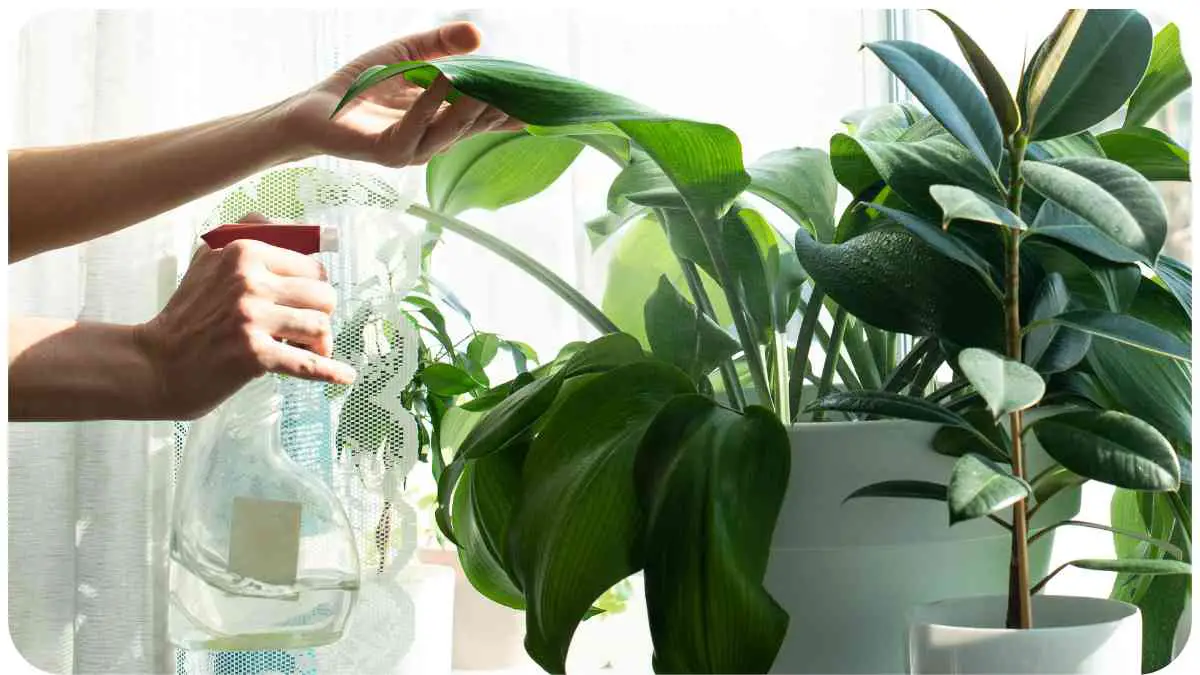Welcome to our comprehensive guide on what to spray on indoor plants! If you’re a plant enthusiast like me, you understand the importance of providing the best care possible for your indoor greenery. One essential aspect of plant care is knowing what to spray on your indoor plants to keep them healthy and thriving.
In this guide, we’ll explore the various options for sprays, including natural remedies, homemade concoctions, and commercial products. Whether you’re dealing with pests, fungal infections, or simply want to promote growth and vitality, we’ve got you covered.
So, let’s dive in and learn how to give your indoor plants the love and attention they deserve!
| Takeaways |
|---|
| Explore homemade pesticide spray recipes using natural ingredients. |
| Learn alternatives to commercial products for controlling pests on indoor plants. |
| Discover effective ways to address pest infestations without harsh chemicals. |
| Experiment with various homemade spray recipes to find what works best for your plants. |
| Ensure proper application and safety precautions when using homemade pesticides. |
| Enhance your indoor plant care routine with DIY solutions for pest control. |
| Enjoy the satisfaction of creating environmentally friendly alternatives for plant care. |
| Empower yourself to tackle common plant problems using accessible ingredients. |
2. Importance of Spraying Indoor Plants

Indoor plants face a unique set of challenges compared to their outdoor counterparts. They are often subjected to dry indoor air, limited sunlight, and pests that thrive in indoor environments. Regular spraying can help mitigate these challenges and promote healthy growth.
To prevent root rot, ensure proper drainage by choosing well-draining soil and pots with drainage holes. Regularly check soil moisture and avoid overwatering. Additionally, consider using natural fungicides for added protection against root diseases.” Comprehensive Guide
By spraying your indoor plants, you can:
- Provide much-needed moisture to their leaves, especially in dry indoor environments.
- Keep pests such as aphids, spider mites, and mealybugs at bay.
- Prevent fungal infections, which can quickly spread in the confined space of indoor environments.
- Promote lush foliage and vibrant blooms, enhancing the overall aesthetic of your indoor space.
Now that we understand why spraying indoor plants is important, let’s delve into some common problems faced by indoor plants and how spraying can help address them.
3. Common Problems Faced by Indoor Plants
Indoor plants can succumb to various issues, ranging from pest infestations to nutrient deficiencies. Here are some common problems you might encounter:
- Pest Infestations: Aphids, spider mites, and mealybugs are just a few of the pests that can wreak havoc on indoor plants.
- Fungal Infections: Damp conditions and poor air circulation indoors can create the perfect breeding ground for fungal diseases such as powdery mildew and botrytis.
- Nutrient Deficiencies: Indoor plants may lack essential nutrients due to poor soil quality or insufficient fertilization, leading to stunted growth and yellowing leaves.
Now that we’ve identified some common problems, let’s explore the solutions.
4. Natural Remedies for Indoor Plant Care

When it comes to caring for indoor plants, many enthusiasts prefer to use natural remedies to avoid exposing their plants to harsh chemicals. Here are some effective natural remedies for indoor plant care:
Introducing praying mantises to your indoor garden can serve as a natural pest control solution. These beneficial insects prey on common indoor pests like aphids and flies, helping to maintain a healthy plant environment without the need for chemical pesticides.” Good for Indoor Plants
Table: Common Natural Remedies for Indoor Plant Care
| Problem | Natural Remedy |
|---|---|
| Pest Infestations | Neem oil spray |
| Insecticidal soap spray | |
| Garlic and chili pepper spray | |
| Fungal Infections | Baking soda solution |
| Chamomile tea spray | |
| Nutrient Deficiencies | Epsom salt solution |
| Banana peel fertilizer |
Using natural remedies not only helps keep your indoor plants healthy but also minimizes the environmental impact of chemical-based products. However, if you prefer the convenience of store-bought sprays, there are plenty of options available.
Shall we explore some DIY homemade plant sprays next, or would you like to learn about commercial plant sprays first?
5. Homemade Plant Sprays
Creating your own plant sprays at home allows you to customize solutions based on your plants’ specific needs. Plus, it’s often more cost-effective than purchasing commercial products. Here are some popular DIY homemade plant spray recipes:
Table: DIY Homemade Plant Sprays Recipes
| Recipe | Ingredients | Benefits |
|---|---|---|
| Neem Oil Spray | Neem oil, mild liquid soap, water | Controls pests, prevents fungal growth |
| Garlic and Chili Pepper Spray | Garlic cloves, chili peppers, water | Repels pests, discourages fungal infections |
| Baking Soda Solution | Baking soda, water | Treats and prevents powdery mildew |
| Chamomile Tea Spray | Chamomile tea bags, water | Fights fungal infections, promotes plant health |
These homemade sprays are easy to make and can be highly effective in maintaining the health and vitality of your indoor plants. Experiment with different recipes to find the ones that work best for your specific plant species.
Now, let’s explore some of the top commercial plant sprays available on the market.
Prevent cockroach infestations in your indoor plants by maintaining a clean environment and sealing any cracks or crevices where these pests can enter. Use natural repellents like neem oil or diatomaceous earth to deter cockroaches without harming your plants.” Keep Cockroaches Out
6. Commercial Plant Sprays
If DIY isn’t your style or you prefer the convenience of ready-to-use products, there are plenty of commercial plant sprays to choose from. Here are some top options:
Table: Top Commercial Plant Sprays on the Market
| Product Name | Active Ingredients | Benefits |
|---|---|---|
| 1. Bayer Advanced 3-in-1 Insect, Disease & Mite Control | Imidacloprid, Tebuconazole | Controls pests, prevents diseases, kills mites |
| 2. Bonide Neem Oil | Neem oil | Organic pest control, safe for indoor use |
| 3. Safer Brand Insect Killing Soap | Potassium salts of fatty acids | Kills insects on contact, gentle on plants |
| 4. Miracle-Gro Leaf Shine | Mineral oil | Restores shine to leaves, enhances appearance |
Commercial plant sprays offer convenience and are formulated to target specific problems such as pests, diseases, and nutrient deficiencies. When choosing a commercial spray, be sure to read the labels carefully and follow the instructions for application.
7. How to Apply Sprays on Indoor Plants
Proper application of sprays is crucial to ensure their effectiveness and minimize any potential harm to your plants. Here are some tips for applying sprays on indoor plants:
- Choose the Right Time: It’s best to spray your indoor plants in the morning or evening when the temperature is cooler and the sun is not as intense. This helps prevent the leaves from burning and allows the spray to be absorbed more effectively.
- Cover All Surfaces: When spraying, make sure to cover both the upper and lower surfaces of the leaves, as well as the stems. Many pests and fungal spores reside on the undersides of leaves, so thorough coverage is essential.
- Avoid Over-Saturation: While it’s important to ensure adequate coverage, be careful not to over-saturate the leaves with spray, especially if using oil-based solutions. Too much moisture can lead to fungal issues and suffocate the plant.
- Rotate Sprays: To prevent pests and diseases from developing resistance to a particular spray, it’s a good idea to rotate between different types of sprays with varying active ingredients.
- Monitor Plants: After applying a spray, monitor your plants closely for any signs of adverse reactions such as leaf discoloration or wilting. If you notice any negative effects, discontinue use immediately and rinse the plants thoroughly with water.
By following these tips, you can ensure that your indoor plants receive the maximum benefit from sprays while minimizing the risk of damage.
Now, let’s discuss some common mistakes to avoid when spraying indoor plants.
Discovering tiny bugs in your houseplants can be unsettling, but it’s a common issue that can be addressed. Regularly inspect your plants for signs of pests, and use natural insecticidal soaps or neem oil sprays to eliminate them safely.” Tiny Bugs in Houseplants
8. Mistakes to Avoid When Spraying Indoor Plants
While spraying can be beneficial for indoor plants, there are some common mistakes that novice plant enthusiasts often make. Here are a few pitfalls to avoid:
- Using the Wrong Spray: Not all indoor plants have the same needs, so using a one-size-fits-all approach to spraying can be detrimental. Make sure to choose the appropriate spray based on your plant’s specific requirements and the problem you’re addressing.
- Overlooking Safety Precautions: Some sprays, especially chemical-based ones, can be harmful if not used properly. Always read and follow the instructions on the label, and wear protective gear such as gloves and goggles when handling potentially hazardous substances.
- Ignoring Integrated Pest Management (IPM) Principles: Spraying should be just one component of a comprehensive pest management strategy. Integrated Pest Management (IPM) emphasizes prevention, monitoring, and using least-toxic methods of pest control alongside sprays.
- Neglecting Regular Maintenance: Spraying is not a one-time solution; it requires ongoing maintenance and vigilance. Make spraying a regular part of your plant care routine, and be proactive in addressing any issues that arise.
Avoiding these common mistakes can help you achieve better results and keep your indoor plants healthy and thriving.
Now, let’s wrap up with a conclusion summarizing the key points we’ve covered in this guide. Shall we?
Achieve optimal growth for your indoor plants by using well-draining soil that promotes proper moisture levels and prevents root rot. Learn how to create the perfect soil mix and understand the importance of good drainage for healthy indoor plant development.” Well-Draining Soil
9. Conclusion
In conclusion, knowing what to spray on indoor plants is essential for maintaining their health and vitality. Whether you opt for natural remedies, DIY homemade sprays, or commercial products, the key is to address the specific needs of your plants while minimizing harm to the environment.
We’ve explored the importance of spraying indoor plants to provide moisture, deter pests, and prevent fungal infections. Additionally, we’ve discussed common problems faced by indoor plants and how spraying can help alleviate them.
From natural remedies like neem oil and garlic-chili pepper spray to commercial products like insecticidal soap and neem oil-based sprays, there are plenty of options to choose from. Each has its benefits and considerations, so it’s essential to select the right spray for your plants’ needs.
Furthermore, we’ve provided tips for applying sprays effectively and highlighted common mistakes to avoid. By following these guidelines, you can ensure that your indoor plants receive the care they need to thrive.
Remember to monitor your plants closely and adjust your spraying regimen as needed based on their response. With proper care and attention, your indoor plants will reward you with lush foliage, vibrant blooms, and a touch of nature’s beauty indoors.
Thank you for joining us on this journey to discover what to spray on indoor plants. Happy spraying and happy gardening!
10. Frequently Asked Questions (FAQs)
Before we conclude, let’s address some frequently asked questions about spraying indoor plants:
Table: FAQs About Spraying Indoor Plants
| Question | Answer |
|---|---|
| What is the best time to spray indoor plants? | The best time to spray indoor plants is in the morning or evening when the temperature is cooler and the sun is not as intense. |
| How often should I spray my indoor plants? | The frequency of spraying depends on various factors such as plant species, environmental conditions, and the presence of pests or diseases. Monitor your plants closely and adjust your spraying regimen accordingly. |
| Can I use water to spray my indoor plants? | Watering your indoor plants is essential for their hydration, but spraying with water alone may not address pest or fungal issues. Consider using targeted sprays with natural or commercial ingredients for specific problems. |
| Are commercial plant sprays safe for indoor use? | Many commercial plant sprays are formulated to be safe for indoor use when used according to the manufacturer’s instructions. However, it’s essential to read the label carefully and take appropriate safety precautions. |
These FAQs aim to provide clarity on common concerns related to spraying indoor plants. If you have any additional questions, feel free to reach out to us for further assistance.
With that, we conclude our guide. Happy gardening, and may your indoor plants thrive and flourish!
Further Reading
Here are some additional resources for further reading on spraying indoor plants:
- 8 Homemade Pesticides Sprays for Indoor Plants: This article provides recipes for homemade pesticide sprays using natural ingredients, offering alternatives to commercial products.
- Natural Pest Control for Houseplants: Discover natural methods for controlling pests on your houseplants, including tips on prevention and treatment.
- 7 Homemade Bug Sprays for Indoor Plants: Explore seven different homemade bug spray recipes specifically designed for indoor plants, using common household ingredients.
FAQs
How do I know if my indoor plants need spraying?
Spraying may be necessary if you notice signs of pests, such as small insects or webs on the leaves, or symptoms of fungal infections, such as white powdery spots or mold growth.
Can I use regular household cleaners as plant sprays?
No, household cleaners are not suitable for use on indoor plants as they may contain harsh chemicals that can damage the plant’s foliage. It’s best to use sprays specifically formulated for plant care.
How often should I spray my indoor plants?
The frequency of spraying depends on various factors, including the type of plant, environmental conditions, and the presence of pests or diseases. Monitor your plants regularly and adjust your spraying regimen accordingly.
Are homemade plant sprays as effective as commercial products?
Homemade plant sprays can be effective, especially for mild pest infestations or fungal infections. However, severe problems may require the use of commercial products that are formulated to target specific pests or diseases.
Are there any safety precautions I should take when spraying indoor plants?
Yes, it’s essential to take safety precautions when spraying indoor plants. Wear gloves and protective eyewear to avoid skin and eye irritation, and ensure proper ventilation when using sprays indoors. Additionally, always follow the instructions on the label carefully.

For 15 years, Hellen James has worked in the gardening industry as an expert and landscape designer. During her career, she has worked for a variety of businesses that specialize in landscaping and gardening from small firms to large corporations.

